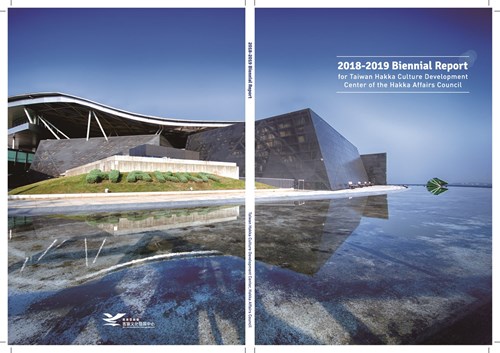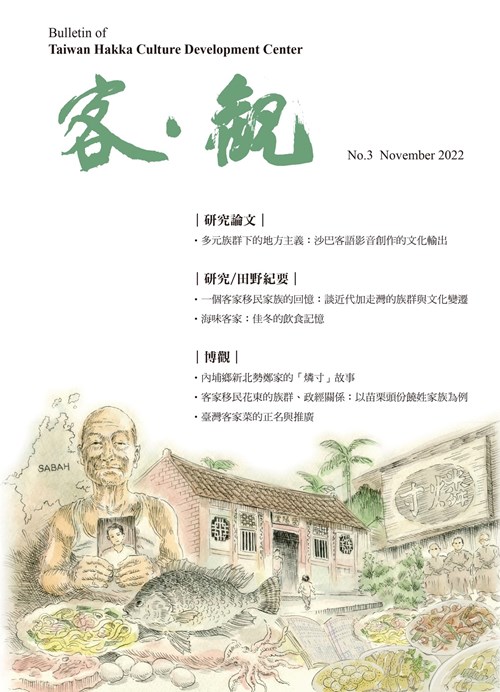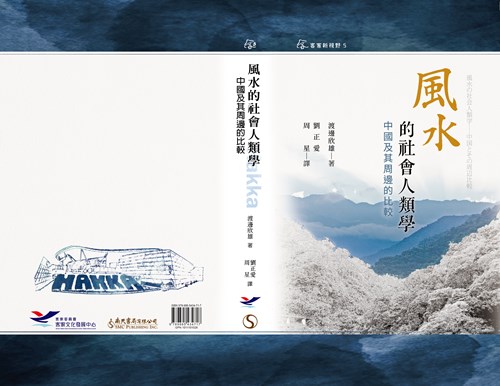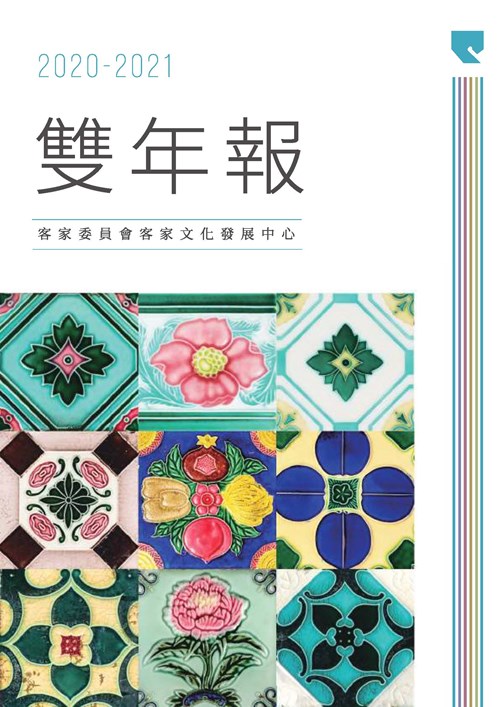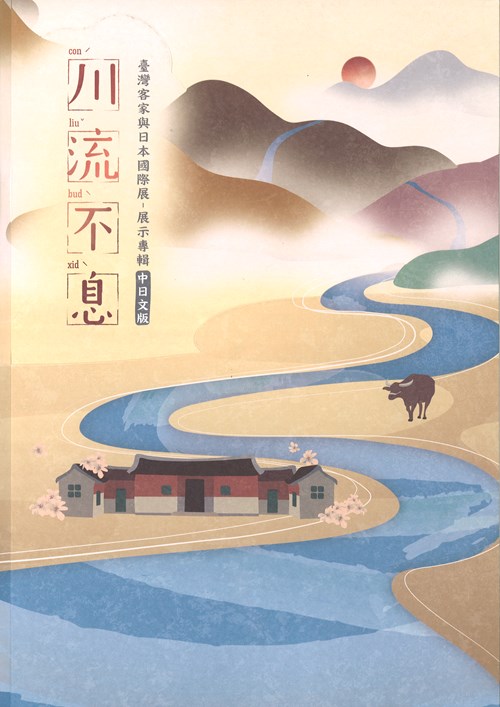
Research & Library
Publications

-
![]()
2018-2019 Biennial Report
Publication Date:The biennial report compiles the researches, collections, exhibitions, extension education and public services of Taiwan Hakka Cultural Development Center (THCDC) during 2018 to 2019. The goal for THCDC is to build the excellent quality museums, to preserve and pass down the Hakka cultural heritage. Publisher / Chin-Liang Ho Executives / Der-Chyi Wu, Chang-Cheng Wu, Yu-Ching Lai, Min-Chen Yao,Mei-Li Yang, Sheng-Lai Chiang Date of Publication First edition published in Decemer 2020 Charge / NT $350 GPN / 1010902419 ISBN / 9789865434182
-
![]()
Siinˇ Mungˇ Repositioning the Hakka in Contemporary Taiwan
Publication Date:「承蒙」,是客家人說謝謝、表示感激、誠心致意的幾種方式之一。本書以承蒙為標題,所表達的是客家族群對臺灣社會的謝意,因為,後者充沛地滋養了客家文化。展示臺灣客家文化,事實上就是試圖呈現客家文化和社會人群互動的成果,客家文化如是豐富,當係承蒙廣體臺灣長期又細膩的滋潤給養。從另外一個方面來看,客家人群作為臺灣社會的重要組成,其文化實作,特別是與周邊人群的互動往來,一起建構了島嶼國度的人文歷史特色。因此,客家臺灣、臺灣客家、客家臺灣文化及臺灣客家文化等的創詞,其意義格外深遠。 展示,作為介紹客家與臺灣的一種方式,期許如其所如的從臺灣認識客家、從客家認識臺灣。客家的源起,以及客家與臺灣相互建構過程的歷史,容或有多種解釋,我們認為,應本於學術研究的基礎,如其所如的展示。客家委員會客家文化發展中心臺灣客家文化館的新常設展,即是基於此一理念的產物。歷史客家、全球客家、常民客家、文化客家及公民客家等五個展示主題,及其相互呼應之架構的提出,源於客發中心多次諮詢會議的決定。常設展主軸即定位於客家與臺灣社會的關係,而整合起五個主題的宏觀視野,正是得以通過認識客家來認識臺灣並再造自若自信的客家。 編/著/譯者 / Wei-An Chang, Shih-Chung Hsieh, Jui-Chao Liu/... 出版機關 / 客家委員會客家文化發展中心 出版日期 / 2021-03 主題分類 / 客家事務 施政分類 / 客家 ISBN / 9789865434212 GPN / 1011000275 頁數/張數/片數 / 240 裝訂 / 平裝 定價 / NT$ 350 85 折優惠價 / NT$ 298 Authors Wei-An Chang, Shih-Chung Hsieh, Jui-Chao Liu Published by Taiwan Hakka Culture Development Center, Hakka Affairs Council Address No.6, Tongke S.Rd.,Tongluo Township, Miaoli County 36645, Taiwan (R.O.C.) Telephone +886-37-985558 Publisher Chin-Liang Ho Editior in Chief Der-Chyi Wu, Chang-Cheng Wu, Yu-Ching Lai, Min-Chen Yao Editional Board Kuo-Feng Hsu, Ling-Yao Chu, Huang Hsiu-Jung Translator Hsiang-Chih Hwang Reviewed by Fen-fang Tsai Design&Printing Linking Publishing Telephone +886-2-86925588 Date of Publication 2021/3 Edition First Edition Charge NTD 350 ISBN 978-986-5434-21-2 GPN 1011000275
-
![]()
2020-2021 Biennial Report
Publication Date: -
![]()
The Bulletin of Taiwan Hakka Culture Development Center (Issue No. 3)
Publication Date:Chief Editor: Lin Pen-hsuanPublication Date: January 2023|Research Articles|• The Localism under a Multi-ethnic Society: The Cultural Output of Sabah Hakka Online ContentBy Bernard Ng Jia Han|Research / Field Reports|• A Hakka Immigrant Family’s Memory: Ethnic and Cultural Transformations in Modern KakacawanBy Lin Jiann-Cherng• The Ocean Taste of Hakka: Food Memories of JiadongBy Tsai Shin-Er|Hakka Forum|• The “Matchstick” Story of the Cheng Family in Xinbeishi, Neipu TownshipBy Cheng Chun-chun & Hung Yi-chen • Ethnic and Political-Economic Relations of Hakka Migration to Eastern Taiwan: A Case Study of the Yao Family from Toufen, MiaoliBy Ho Lai-mei • Naming and Promoting Taiwanese Hakka CuisineBy Chang Jung-chia
-
![]()
The Social Anthropology of Fengshui
Publication Date:Author: Watanabe YoshioTranslators: Liu Zheng-ai and Zhou XingPublication Date: First Edition, August 2022Fengshui (風水) holds a central place in Hakka culture, making its study an important path to understanding Hakka society. Professor Watanabe Yoshio began his fieldwork in Taiwan in 1978, conducting long-term ethnographic research in the Liugdui Hakka region of Pingtung. Beyond Taiwan, he has carried out extensive anthropological investigations across East Asia, including Japan, Okinawa, and mainland China.Drawing upon decades of field experience and research, Watanabe published The Social Anthropology of Fengshui: Comparative Studies of China and Its Surrounding Regions in 2001. The book sought to address the widespread misunderstandings surrounding Fengshui that arose during the surge of popular interest in the subject, presenting a rigorous anthropological interpretation of its social and cultural dimensions.This translated edition systematically explores the definition, historical study, and theoretical framework of Fengshui, while introducing rich ethnographic materials collected by the author—ranging from statistical data on Fengshui beliefs to detailed case studies based on interviews and site observations. Through these vivid local accounts, the book reveals the cultural logic and lived practices of Fengshui in everyday life.As one of the most significant anthropological works on the subject, The Social Anthropology of Fengshui provides not only textual analysis but also a record of field exploration, offering readers in the Chinese-speaking world a deeper academic understanding of Fengshui and its place in East Asian cultural history.
-
![]()
The Modern Composition of Hakka Studies
Publication Date:Authors: Nakagawa Manabu, Tai Kuo-hui, Hashimoto Mantaro, Lin Geng, and Sakamoto HirokoTranslator: Lai Hsu-chenPublication Date: First Edition, August 2022The “Theory of Central Plains Origin,” advanced by scholars such as Lo Hsiang-lin, has long been a dominant perspective in Hakka studies and a key component of many Hakka people’s sense of ethnic identity. However, Japanese scholar Nakagawa Manabu, through extensive textual analysis and critical inquiry, reexamines this prevailing understanding of Hakka identity. He introduces two analytical concepts—“reality” (真實) and “fact” (事實)—to articulate a more nuanced view.According to Nakagawa, “reality” refers to the realm of psychological and subjective consciousness, while “fact” denotes verifiable reality established through systematic academic inquiry. Based on this foundation, the book investigates the relationship and tension between “reality” and “fact” in the Hakka spirit, exploring how collective identity is formed, justified, and reconstructed.Centered on Nakagawa’s essay “The Political and Economic Historical Image of the Hakka Chinese,” this volume examines themes such as Hakka political economy, ancestral origins, the Chongzhen (崇正) spirit, and social-economic organization, tracing the interplay between factual analysis and lived experience to construct a modern intellectual framework for Hakka studies.In addition to Nakagawa’s work, this collection includes essays by Tai Kuo-hui, Hashimoto Mantaro, Lin Geng, and Sakamoto Hiroko, whose diverse perspectives opened new horizons in Hakka scholarship. Together, these writings not only compile foundational studies in the field but also showcase the intellectual dialogue and cross-cultural interpretations that continue to shape contemporary understandings of Hakka identity.
-
![]()
The Bulletin of Taiwan Hakka Culture Development Center (Issue No. 2)
Publication Date:Chief Editor: Lai Yu-chingPublication Date: May 2022 |Research Articles|• Hakka Population Migration and Language Loss in Taiwan• Humans, Deities, and Associations: Social Relations in Hakka Religious Practices in Singapore and Malaysia |Research / Field Reports|• Plate-flowers Offering: Offerings, Gifts, and Medicinal Objects• Pre-Exhibition Study Notes on “Railways and the Hakka” |Reviews|• Review of The Hakka Cookbook: Chinese Soul Food from around the World, written by Lau Anusasananan, Linda. 2012. University of California Press. |Hakka Forum|• Reflections on Hakka Cuisine• Similarities and Differences in Hakka Foodways across the Taiwan Strait• The Yi-Min Shrine in Jiaxian: A Unique Site of Interethnic Harmony and Hakka Identity• “Traveling through Hakka Villages”: Bagˋ Gungˊ’s (the Earth God’s) Reunion
-
![]()
The Biennial Report of Hakka Cultural Development Center, 2020–2021
Publication Date:Chief Editor: Lai Yu-chingPublication Date: First Edition, May 2022The Biennial Report 2020–2021 compiles an overview of the Hakka Cultural Development Center’s key undertakings across its northern and southern cultural parks, including activities in research and publication, cultural heritage preservation, exhibitions and performing arts, educational outreach, and public services.In celebration with the Center’s 10th anniversary, the report also features special articles reviewing the development and achievements of both parks over the past decade. These include a chronology of major milestones, as well as summaries of field investigations, collections, exhibitions, and publications, providing readers with a comprehensive record of the Center’s decade-long dedication to preserving and promoting Hakka culture.
-
![]()
A Never-Ending Stream: The Taiwanese Hakka and Japan International Exhibition Catalogue
Publication Date:Chief Editors: Lai Yu-ching and Hung Deng-chinAuthors: Ho Chin-liang, Kawai Hironao, Hung Deng-chin, Hsu Fang-chih, Chang Wei-an, Lai Yu-ching, and Lai Po-jo (listed in order by Chinese surname)Publication Date: May 2022A Never-Ending Stream: The Taiwanese Hakka and Japan International Exhibition represents one of the key outcomes of a six-year academic cooperation agreement signed among the Hakka Cultural Development Center, Hakka Affairs Council; the National Museum of Ethnology, Japan; and the College of Hakka Studies, National Yang Ming Chiao Tung University. The exhibition’s premiere was held in August 2020 at the Taiwan Hakka Museum of the Hakka Cultural Development Center.The exhibition is organized around three major themes:1. Records of Hakka Life during the Japanese Colonial Period – featuring materials such as Hakka language textbooks from the Japanese era, the Hakka people’s contributions to local industries and community life, scenes of everyday life in Hakka villages, the development of baseball in Hakka communities, and notable Hakka writers and musicians of the time.2. Hakka People Living in Japan – introducing distinguished Hakka individuals who have worked diligently and achieved success in Japan, the development and activities of Hakka associations there, and the cultural connections between Japan and the Hakka through the Xu Fu (徐福) belief tradition.3. Japanese Scholars and Hakka Studies in Taiwan – highlighting recent collaborative research and exchanges between Taiwanese and Japanese scholars in the field of Hakka studies.This catalogue compiles the complete content of the exhibition, presenting the interwoven histories and ongoing cultural exchanges between the Hakka of Taiwan and Japan—a relationship that continues to flow, like a river without end.
-
![]()
One Crowded Moment of Glory: The Kinabalu Guerrillas and the 1943 Jesselton Uprising
Publication Date:Malaysia 2019 National Book AwardMalaysia 2021 National Academic Publishing Association Award Who were they fighting for? And why? On October 9, 1943, a Saturday evening, the Kinabalu Guerillas sallied forth. The plan was a surprise attack on Tuaran police station to liberate that town from the hands of the Japanese. There followed a night attack on Jesselton (Kota Kinabalu). October 12, 1943. With countless dead and injured from the guerrilla raid, the humiliated and furious Japanese swore to take full revenge. It is reported that on the way to Inanam the Japanese shot at anything that moved. In World War II, a group of young ethnic Chinese in Malaysia (primarily Hakka) organized themselves into the “Kinabalu Guerrillas,” banding together with local islanders to resist the tyrannical Japanese military occupation. On an early Autumn evening their successful surprise attack temporarily liberated Jesselton. But they also drew a swift and brutal reprisal from the Japanese army that included the imprisonment and indiscriminate killing of locals and the massacre at Petagas. After peace returned to Sabah, the colonial government in Petagas erected a war memorial and Sabah locals have long remembered the brave deeds of the Kinabalu Guerrillas, who embodied the spirit of their pursuit of freedom and of heroic struggle against a far more powerful enemy. Publishers: National Yang Ming Chiao Tung University Press, Hakka Affairs Council Taiwan Hakka Culture Development CenterAuthor: Danny Wong Tze Ken (Director, Faculty of Arts and Social Sciences, University of Malaya)Chinese Translation: Chung Yi-niISBN: 978-9865434465Published: November 2021

